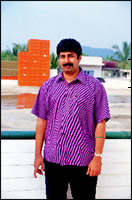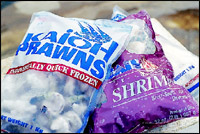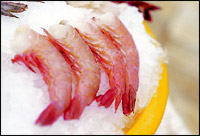


|
|
|
SREERAM Atluri, of Nekkanti Seafoods in Visakhapatnam, is credited with being India's third largest exporter of shrimps to the world. That is cultured shrimps, grown in ponds of brackish water and other fresh water sources, and not the wild-caught variety of the deep sea. He exports his shrimps with the heads on and headless; peeled and deveined and with the tails on; peeled and deveined and with the tails off; and peeled completely. This is done in a large plant within Vizag, where the shrimp is processed, frozen, stored and then exported.
It's very simple, actually. What Nekkanti Seafoods does in Vizag is physically rear the shrimps like a farmer might do with chicken on a poultry farm, and then process it and sell it to food service outlets and retailers in the US, Europe, Australia and Japan. Hotels, restaurants, seafood distribution companies, and caterers abroad are Sreeram's big clients. Not a single shrimp is sold in India! His products, under different brand names, also find themselves in shopping markets in these countries where seafood lovers buy them off the refrigerated shelves.
The shrimp then remains in Nekkanti Seafoods' pond and is grown for upto 120 days to become the Black Tiger prawn or 180 days to become the freshwater shrimp. It is then either block frozen or individual quick frozen (IQF) and exported. When it is going to a wholesaler, or a hotelier, restaurateur or seafood distributor, then the shrimp is block frozen. �The food service people abroad take it and reprocess it,� says Sreeram. �But when it goes to a buyer who puts it directly on the shelf, then he wants the shrimp branded. These people give us their design and barcode number and we print international quality bags and send them the IQF variety of shrimp meant directly for sale.�
Nekkanti Seafoods also exports cuttle fish, pomfret, king fish, the deep sea lobster, and the blue swimming crab. This is all caught by mechanised boats, trawlers and country crafts of the Vizag coast. They have deep sea trawlers that can remain out fishing for as long as 40 days. These trawlers are equipped with freezing and storing facilities. They go to the North-East Gangetic waters and the Sunderbans. The deep sea lobster is caught in Sri Lankan waters. �We have a licence to fish there,� says Sreeram Atluri earnestly. �Aqua-culture failed as a business at corporate level. But the small-time farmer has been successful.�
|

Home Page
About the mag
Subscribe
Advertise
Contact Us

 Vizag Shrimp Goes To Global Markets
Vizag Shrimp Goes To Global Markets
 �We are called seafood processors and exporters,� Sreeram explains. �And our business is hugely successful because there is a general depletion of seafood resources around the world. People have now started depending on aqua-cultured fish, which countries like India, Thailand, Vietnam and Indonesia are better placed to deliver because of the availability of manpower, conducive climate and suitable land-water resources.� Andhra Pradesh is the main state for this business, it accounts for 70 per cent of the produce of cultured shrimp in India. West Bengal and Orissa come next. And there are pockets on the West coast in Maharashtra and Gujarat too, where seafood processors and exporters function from.
�We are called seafood processors and exporters,� Sreeram explains. �And our business is hugely successful because there is a general depletion of seafood resources around the world. People have now started depending on aqua-cultured fish, which countries like India, Thailand, Vietnam and Indonesia are better placed to deliver because of the availability of manpower, conducive climate and suitable land-water resources.� Andhra Pradesh is the main state for this business, it accounts for 70 per cent of the produce of cultured shrimp in India. West Bengal and Orissa come next. And there are pockets on the West coast in Maharashtra and Gujarat too, where seafood processors and exporters function from. Sreeram explains the method of seafood processing: �The mother prawn is from the deep sea. It is stimulated to produce eggs in our hatchery. That's where the process starts. The shrimp-seed that is produced in the hatchery goes through a 25-day lifecycle that takes it from egg stage to post-larvae. This is known as the shrimp fry. When it has reached this stage, it is introduced to ponds close to the sea, and other inland water bodies like canals and backwaters where conditions are suitable for the growth of the shrimp.�
Sreeram explains the method of seafood processing: �The mother prawn is from the deep sea. It is stimulated to produce eggs in our hatchery. That's where the process starts. The shrimp-seed that is produced in the hatchery goes through a 25-day lifecycle that takes it from egg stage to post-larvae. This is known as the shrimp fry. When it has reached this stage, it is introduced to ponds close to the sea, and other inland water bodies like canals and backwaters where conditions are suitable for the growth of the shrimp.� Shrimps can be as expensive as $25 a kilo and as cheap as $2 a kilo. The internationally accepted system is number of pieces per pound. The $24 a kilo variety will hardly give you ten shrimps. Whereas the $2 variety which includes even broken shrimps, can have as many as 500 shrimps a kilo. Nekkanti Seafood stores its products at -18 degrees C. At this temperature, it can stay as long as 18 months. The freezing and long storage does not alter the taste of the shrimp. Not if the process was done when the shrimp was fresh. However, Sreeram agrees that the sea-caught shrimp does have better taste and texture. He himself is a big seafood lover. He will not eat chicken and meat when there is fish available, he says.
Shrimps can be as expensive as $25 a kilo and as cheap as $2 a kilo. The internationally accepted system is number of pieces per pound. The $24 a kilo variety will hardly give you ten shrimps. Whereas the $2 variety which includes even broken shrimps, can have as many as 500 shrimps a kilo. Nekkanti Seafood stores its products at -18 degrees C. At this temperature, it can stay as long as 18 months. The freezing and long storage does not alter the taste of the shrimp. Not if the process was done when the shrimp was fresh. However, Sreeram agrees that the sea-caught shrimp does have better taste and texture. He himself is a big seafood lover. He will not eat chicken and meat when there is fish available, he says.